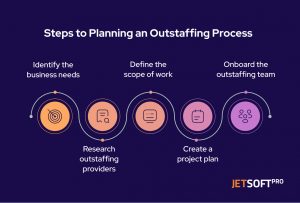As the business landscape continues to evolve rapidly, companies are consistently exploring new avenues to reduce expenses while preserving the quality of their operations. Outstaffing has emerged as a popular solution in recent years. In this article, we will explain the concept of outstaffing, highlight its advantages over conventional hiring methods, and guide you through the process of establishing an outstaffing framework that can effectively cut costs without compromising quality.

Understanding the Benefits of Outstaffing
Outstaffing is a business practice where a company hires staff through a third-party provider rather than directly employing them. The third-party provider, also known as an outstaffing partner, takes care of the recruitment, payroll, and HR management of the staff. The staff then work exclusively for the hiring company, providing services and performing tasks as directed by the hiring company.
Benefits of Outstaffing over Traditional Hiring Methods :
- Cost Reduction
Outstaffing allows companies to cut down on their overhead costs, as they do not need to spend money on recruitment, payroll, benefits, and other expenses associated with full-time employees. Companies only pay for the specific services that the outstaffing partner provides, resulting in significant cost savings.
- Access to a Broader Talent Pool
Outstaffing enables companies to tap into a larger talent pool, as the outstaffing partner has access to a wider range of qualified professionals with varying skill sets. This allows companies to quickly find and hire the best talent without having to go through the lengthy recruitment process.
- Scalability
Outstaffing allows companies to quickly scale their workforce up or down as needed, without the need for complex HR management. This is particularly useful for companies that experience seasonal fluctuations in demand, as they can hire staff on a project-by-project basis.
- Flexibility
Outstaffing provides greater flexibility than traditional hiring methods, as companies can easily adjust the scope of their projects and services to meet changing business needs. This enables companies to remain agile and responsive to market changes, which is particularly important in today’s fast-paced business environment.
- Reduced Administrative Burden
Outstaffing relieves companies of the administrative burden associated with HR management, including payroll, benefits, and compliance with employment laws and regulations. This frees up valuable time and resources, allowing companies to focus on core business activities and achieving their strategic goals.
- Mitigated Risks
Outstaffing also helps companies mitigate risks associated with traditional hiring methods, such as employee turnover, legal liabilities, and the cost of employee benefits. With outstaffing, companies can avoid these risks, as the outstaffing partner assumes responsibility for managing and retaining their workforce.
These benefits enable companies to remain competitive, responsive to market changes, and focused on achieving their strategic goals.
Examples of Companies that have Successfully Implemented Outstaffing:
- Google has been outsourcing its non-core functions to third-party providers for many years. By doing so, the company has been able to focus on its core business functions and maintain its competitive edge.
- Skype, the popular video and voice calling app, has outsourced its customer support operations to an outstaffing partner. This has allowed the company to provide quality customer support to its users while reducing costs.
- Microsoft outsources many of its software development functions to third-party providers. This has allowed the company to rapidly develop and launch new software products while maintaining quality and cost-effectiveness.
Planning Outstaffing for Cost Reduction and Quality Improvement
Outstaffing is becoming an increasingly popular option for companies to save costs and improve the quality of their work. However, planning an outstaffing process can be a daunting task. In this article, we will provide a step-by-step guide to planning an outstaffing process, identifying cost-saving opportunities, and improving the quality of work through outstaffing.

Steps to Planning an Outstaffing Process:
- Identify the business needs The first step in planning an outstaffing process is to identify the business needs. Determine which functions are non-core to the business and can be outsourced to a third-party provider. Identify the skills and expertise required for the outsourced functions.
- Research outstaffing providers Research outstaffing providers and choose one that has a good reputation, experience in the industry, and a good track record. Look for an outstaffing partner that has a pool of qualified professionals with the skills and expertise required for the outsourced functions.
- Define the scope of work Define the scope of work and the specific tasks to be outsourced. Create a clear and concise job description and identify the performance metrics and key performance indicators (KPIs) that will be used to measure the success of the outstaffing process.
- Create a project plan Create a project plan that includes timelines, milestones, and deliverables. Establish a communication plan to keep all stakeholders informed and aligned with the project goals.
- Onboard the outstaffing team Onboard the outstaffing team and provide them with the necessary training, tools, and resources required to perform their tasks. Establish clear communication channels and protocols to ensure that the outstaffing team is integrated into the company culture and values.
Identifying Cost-Saving Opportunities through Outstaffing
In today’s highly competitive business landscape, it is imperative for companies to continuously look for ways to cut costs without compromising the quality of their products or services. Cutting costs through outstaffing has become even more essential in 2023 due to a variety of factors.

One of the most significant is the ongoing economic uncertainty caused by the COVID-19 pandemic and now we have one more factor – worldwide recession.
Many businesses have experienced a decline in revenue and are seeking ways to reduce expenses in order to remain financially viable. Additionally, the rising costs of labor, office space, and other operational expenses have made it increasingly challenging for companies to maintain profitability.
Outstaffing provides numerous cost-saving opportunities for companies, including:
- Reduced Overhead Costs
Outstaffing allows companies to reduce their overhead costs, including recruitment, payroll, benefits, and other expenses associated with full-time employees.
- Access to Affordable Labor Markets
Outstaffing enables companies to access affordable labor markets, where the cost of living and wages are lower than in developed countries. This allows companies to hire highly skilled professionals at a fraction of the cost of hiring local employees.
- Scalability
Outstaffing allows companies to quickly scale their workforce up or down as needed, without the need for complex HR management. This is particularly useful for companies that experience seasonal fluctuations in demand, as they can hire staff on a project-by-project basis.
How Outstaffing Can Improve the Quality of Work
Outstaffing can also improve the quality of work in several ways, including:
- Access to a Broader Talent Pool
Outstaffing enables companies to tap into a larger talent pool, as the outstaffing partner has access to a wider range of qualified professionals with varying skill sets. This allows companies to quickly find and hire the best talent without having to go through the lengthy recruitment process.
- Specialized Expertise
Outstaffing allows companies to access specialized expertise that may not be available in-house. This can lead to higher quality work and improved outcomes.
- Increased Efficiency
Outstaffing can increase the efficiency of work processes, as the outstaffing partner is responsible for managing HR, recruitment, and payroll. This allows companies to focus on their core business functions and improve overall productivity.
Quality Outcomes Start with the Right Outstaffing Partner
Quality outcomes are critical to the success of any business, and the right outstaffing partner can help achieve those outcomes. Outstaffing, also known as staff augmentation, is a practice that allows companies to hire qualified professionals for short-term or long-term projects through a third-party service provider.

Choosing the right outstaffing partner is essential to achieving quality outcomes. Here are some factors to consider when selecting an outstaffing partner:
- Expertise and Experience. An outstaffing partner should have expertise in the specific skills required for the project. Look for a partner with experience working with companies in your industry and a track record of delivering quality work.
- Quality Control Processes. Ensure the outstaffing partner has effective quality control processes in place to ensure the work delivered meets your standards. Ask about their quality control procedures, including how they monitor and measure performance.
- Communication and Collaboration. Effective communication and collaboration are crucial to the success of any project. Choose an outstaffing partner that has a proven communication and collaboration process to ensure everyone is on the same page and working towards the same goals.
- Scalability. Your outstaffing partner should have the ability to scale up or down quickly as needed. Ensure they have the capacity to handle additional resources if required, and that they can reduce the workforce when the project is complete.
- Cost-Effectiveness. While cost is not the only factor to consider, it is essential. Ensure that your outstaffing partner provides cost-effective solutions that fit within your budget. Consider the fees, rates, and any hidden costs before signing an agreement.
By choosing the right outstaffing partner, companies can achieve quality outcomes and maximize the benefits of outstaffing. The right partner can help companies save costs, improve productivity, and enhance the overall quality of work.
JetSoftPro can become your trusted outstaffing partner that can help you achieve your business goals with custom technology solutions tailored to your needs. Also, offers exceptional customer service, and has vast expertise in renewable energy software solutions, wfm platform development, drone management applications and way more. One of the main reasons to choose JetSoftPro is its positive reputation. With excellent Clutch reviews, JetSoftPro has a proven track record of delivering high-quality work and exceptional customer service.
Consider JetSoftPro for your next project and experience the benefits of working with a trusted outstaffing partner.
Summing Up
To conclude, outstaffing is an effective business strategy for companies to minimize expenses while maintaining quality standards. Outstaffing offers numerous benefits over traditional hiring methods, including cost reduction, access to a broader talent pool, and scalability. Successful examples of companies that have implemented outstaffing include Google, Skype, and Microsoft.
When planning for an outstaffing process, companies should identify their business needs, research outstaffing providers, define the scope of work, create a project plan, and onboard the outstaffing team. Outstaffing also provides cost-saving opportunities for companies, including reduced overhead costs, access to affordable labor markets, and scalability.
Lastly, outstaffing can improve the quality of work by providing access to specialized skills, resources, and technology, enabling companies to focus on their core competencies and remain competitive in today’s rapidly evolving business landscape.

